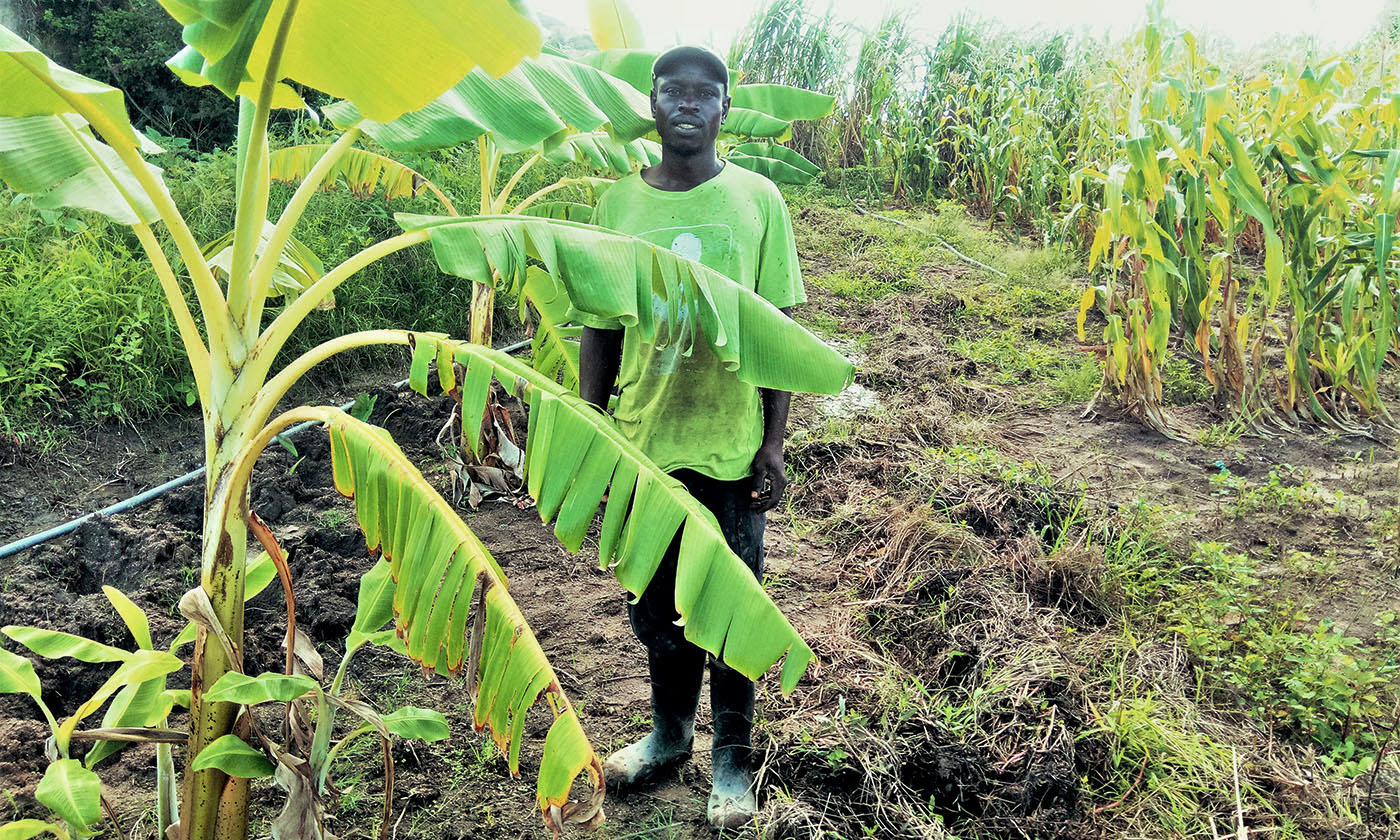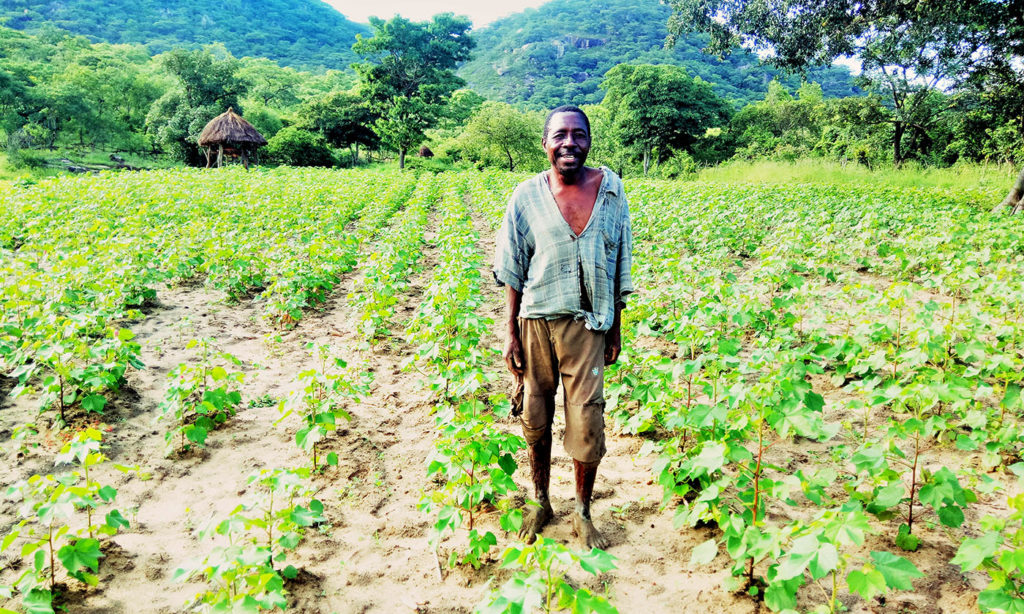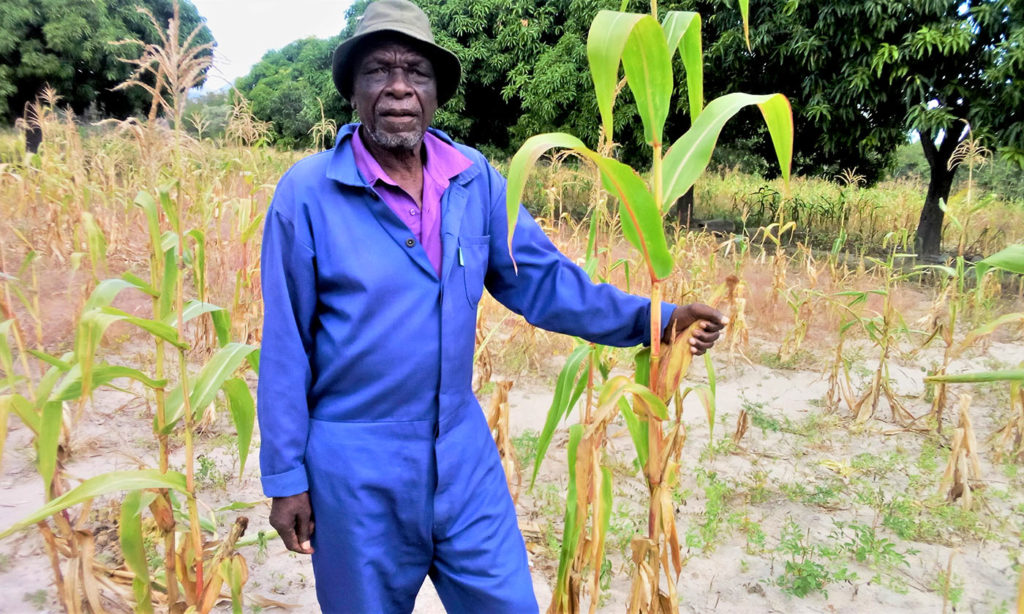
Stephen Chihota cannot hide his joy as he strolls his 2-hectare farm. “We’re expecting a good harvest of maize and cotton this season,” Chihota says, beaming. He is a new settler in a mushrooming village in the sprawling foothills of Zimbabwe’s Eastern Highlands. Chihota has every reason to be in high spirits—hardly five years ago, he was a farmer in Dzobo, a dry area to the west, struggling to harvest enough to feed his family.
Frequent droughts since 1992 have affected low-lying areas in most parts of Zimbabwe, making rain-fed agriculture without irrigation untenable in places such as Dzobo. Of the country’s 10 provinces, five of them—Manicaland, Masvingo, Midlands, Matabeleland South, and Matabeleland North—have been greatly affected by the droughts. The amount of rainfall here dwindles with each passing season. In 2019 the Food Security Early Warning System determined that the total rainfall between October 2018 and early February 2019 in some parts of Zimbabwe was among the lowest in 40 years.
The search for clean water, sufficient rainfall, rich soils, and good pastures for livestock has triggered the migration of people, including Chihota, from dry areas of Zimbabwe to the country’s Eastern Highlands. Here, makeshift mud huts under grass thatch, crudely built by the new settlers, dot the foothills of the mountains, broken by a mosaic of green maize and cotton patches.
“Our lives have changed for the better since we came to this area,” says Chihota, a father of five. “We are now able to harvest enough food for our family. We’re also able to sell the surplus and send our children to school.”
The Eastern Highlands stretch for about 200 miles, from Nyanga district in the north to Chipinge district in the south, forming Zimbabwe’s border with Mozambique. The Eastern Highlands have a longer rainy season than the rest of Zimbabwe—lasting from October to April—making the region suitable for diversified farming, including cattle and plantation and orchard crops.
The climate crisis is a result of human action, irrespective of national or continental boundaries, thus an area of mutual interest.
Nourished by a wealth of perennial rivers and streams, the Eastern Highlands are home to a variety of wild animal and plant species. The constant blanket of fog that covers most parts of the Eastern Highlands in summer can, at times, bring a dreary feeling. But during this season, old trucks with loads of fresh farm produce snake through the treacherous muddy roads to the markets at the nearby city of Mutare. Bananas, potatoes, fresh leaf vegetables, and tomatoes are among the common crops from this area.
“I tried to look for a job in the city of Mutare, but life was very hard in the city,” says Alfiosi Magadzire, who in 2016 moved his family from the dry Masvingo province to the Eastern Highlands to farm. “With this piece of land I’m now able to grow my own food. I was able to buy some cattle and goats. I’m now very happy with my life here.”
Research conducted by Dick Ranga from the Zimbabwe Open University in 2019 confirms that people from drier areas are migrating en masse to the Eastern Highlands in search of good rains. As of 2016, more than 20,000 climate migrants had moved to the region, according to a former minister of Manicaland Province.
But even here, conditions are changing. Climate change and the refugees it creates are having an increasing impact on the region. Rainfall diminishes year over year, and the soils are reaching their limits of productivity. The government of Zimbabwe is collaborating with nongovernmental organizations and development groups to create income-generating activities for families who would otherwise be forced to leave their homes in search of work or farming opportunities. The results so far are early and small-scale but are sowing seeds of hope for Zimbabweans.

Community support
Until the early 1980s, the farms in the Eastern Highlands were owned by White colonial farmers who relied on Zimbabwean laborers. When the country gained independence from Britain in 1980, the government began to acquire the land to resettle Indigenous Black Zimbabweans as part of the country’s land reform program.
Then around 2014, climate refugees from dry areas started showing up in the Eastern Highlands. At first they were greeted with resentment by the farmers who had been formally resettled in the area by the government. The existing farmers tried to put pressure on the government to evict the new farmers.
The Zimbabwean government, for its part, does not condone the actions of the refugees, which it labels “illegal settlers.” On numerous occasions, the government has threatened to evict them, but so far it has not followed through.
“We were not happy at first,” says Cephas Madhinga, a farmer who has been living in the Eastern Highlands since the early 1980s. “Though of late we have been observing lower rainfall in this area than before…[so] we’re trying to live peacefully with these new settlers.”
As the effects of a warming climate are now reaching the Eastern Highlands, he says they have observed and now understand how droughts have been impacting Zimbabweans living in low-lying areas.
“We feel for the affected people, and the only thing we can do is to accommodate them here,” he says, but “we hope the government will soon find a lasting solution to issues related to the new settlers, because this area will not continue to accommodate more new people.”
As rains diminish and soils get depleted of nutrients, the capacity for supporting farmers—old or new—may decrease. In 2019 the harvest of maize (a staple in Zimbabwe) was estimated to satisfy only 40% of the nation’s consumption needs, according to the Food and Agriculture Organization. That same year, the national cattle herd decreased by 4.7% due to drought and tick-borne diseases.
We have a small window now, before the effects of climate change deepen, to prepare the ground for this new reality.
Blessing Muraga, another farmer in the area, is both empathetic and realistic about the situation: “We will not chase them away. They also need to feed their families, but soon we will run out of land to graze our livestock.”
Some traditional leaders insist on assisting these refugees. “We can’t let these people die of hunger. All they want are small pieces of land to grow their crops and have enough to eat,” says Phebion Chadambuka, an octogenarian traditional leader in the area. Chadambuka says he has been allocating small pieces of land for landless families to build their new homes and graze their livestock. He has also helped to persuade local farmers to accept the new settlers.
“We must assist each other and work together as Zimbabweans in these hard times,” Chadambuka says.
Sustainable alternatives
To slow the migration of people because of drought, the Zimbabwean government is collaborating with development partners and nongovernmental organizations to work on climate-change-related projects, such as developing and rehabilitating irrigation facilities. Between 2016 and 2017, World Vision Zimbabwe supported the development of nutrition gardens, microirrigation schemes, and water harvesting weirs, which benefited more than 600 households in Chimanimani district’s dry areas. Some of these projects were done in collaboration with USAID through the Enhancing Nutrition, Stepping up Resilience and Enterprise grant aimed at addressing the El Niño-induced drought that affected Zimbabwe in 2015 and 2016.
Washington Zhakata, director of the climate change management department in Zimbabwe’s Ministry of Lands, Agriculture, Water, Climate and Rural Resettlement, says these water and nutrition projects need to be income-generating. They aim to substitute for the income from agriculture as conditions worsen. According to United Nations Development Programme, there has been an overall decline of 5% in rainfall across Zimbabwe during the past century.
Zhakata points to a successful example in the drought-prone village of Chapanduka, in the Buhera district: “The department provided the community with beehives, a honey processing center, and solar-powered water conveyance system. The community is now generating income enough to sustain their lives,” he says. “If more projects and programs of this nature are implemented, then, gradually, the issue of climate migration may be slowed down.”

Displacement by disasters
In neighboring Mozambique, research shows that the country’s densely populated coastal area could lose up to 1,873 square miles of land by 2040 because of climate change, including flooding and sea-level rise. This would force more than 1 million people to migrate to the country’s inland areas.
And this is hardly an isolated case. Across the globe, residents of small island states such as Kiribati, the Maldives, and the Bahamas have been displaced by rising sea levels. In the Marshall Islands, flooding, sea-level rise, and the intrusion of saltwater into freshwater supplies have forced many people to migrate, according to a recent report. “Persistent drought is further affecting agricultural production and access to drinking water,” according to the report.
One challenge in supporting people in these situations is deciding who is or isn’t considered a climate migrant. Governments and development organizations rely on such definitions to distribute their support. A report by the International Organization for Migration says “the lack of an accepted definition of an environmental refugee means that, unless they’re relocated by extreme weather events, their displacement does not trigger any access to financial grants, food aid, tools, shelter, schools, or clinics.”
That makes it all the more important for communities and countries to find ways to welcome and support climate migrants.
A human-caused crisis
Back in the city of Mutare, in the Eastern Highlands, research on climate migration is underway in collaboration with a sister city in the Netherlands. Gift Sanyanga, who coordinates the Haarlem Mutare City Link, says, “Our communities or cities are not exempt from these adverse effects, though in varying forms.” That’s why the group is building capacity and pooling resources across continents to come up with resilience measures.
The group’s immediate objective is to bring the issue of climate migration to the fore by engaging local authorities, government departments, environmentalists, grassroots communities, academia, media, and donor communities. “The climate crisis is a result of human action, irrespective of national or continental boundaries, thus an area of mutual interest,” Sanyanga says.
By 2050, the impacts of climate change could result in 140 million people moving within their borders, according to a report by the World Bank in 2018. The study focused on the nexus between climate change impacts, internal migration patterns, and development in sub-Saharan Africa, South Asia, and Latin America. To reduce the climate pressure on people and livelihoods, as well as the scale of climate migration, the report recommends cutting global greenhouse gas emissions and encourages transforming development planning to factor in the entire cycle of climate migration.
“It’s also important to help people make good decisions about whether to stay where they are or move to new locations where they are less vulnerable,” said Kristalina Georgieva, then World Bank chief executive officer, in a news release that accompanied the report. “We have a small window now, before the effects of climate change deepen, to prepare the ground for this new reality.”


